Ring the bells that still can ring. Forget your perfect offering. There is a crack, a crack in everything.
That’s how the light gets in. —Leonard Cohen

Mindfulness
Like many, I’m often a bit more reflective about my life at the beginning of each year. As we start our journey once again around the sun, I’ve been thinking about how I want to live and what will be my intentions for each day and each moment of my precious new year of life. Thoughts have focused on how I want and need to grow—as a mother, wife, professional, friend, blogger and person in general. Reflections abound on what I can do to live those roles more purposefully and mindfully, and become a better, more loving, friendly, compassionate, and generous version of my current self.
In Bhante Gunaratana’s book, “Mindfulness in Plain English”, he says, Improving ourselves is the unswerving path to the perfection that is our goal in life. Before we try to surmount our defects, we should know what they are. Then, and only then, by overcoming these weaknesses, can we cultivate noble qualities hidden deep down in our subconscious mind. Easier said than done. Pride and a variety of other reasons often keep us from accepting our faults. As we all have blind spots, we should be thankful to others who expose our faults, they act as a mirror for us to see our faults with wisdom. I have many of those mirrors, some a little more difficult to look at than others. My son, at times, is one mirror.

The Human Voice
When I look at my son’s hands, it is one of the many times I am reminded of just how small, impressionable, vulnerable, capable, and beautifully amazing he is. Little dimples at the base of each finger remind me of the honor and responsibility I have in being his mother and of the influence my actions, my mood, and particularly my voice have on his well-being.
The human voice is the music that can often calibrate our days. Its intonation and rhythm can be a clear blue stream or the cloudiness of still and turbid water. The voice can soothe, hurt, anger, terrify or becalm. Words and sounds we hear from strangers, friends and family energize and saturate our sensibilities, becoming companions for us to carry along our way. The opportunity to participate in the rich and wonderful cacophony around us is beautiful and something of which to be very mindful.

Cracks
In Louise Bates Ames’ book, Your Three-Year-Old: Enemy or Friend, she says the age of three is a conforming one. At this age children are typically calm emotionally, happy socially, and secure physically. Liking to please, they conform easily. Around three and a half, the current age of my son, you often have just the opposite, she explains. Even the simplest of routines—eating, going to the bathroom, taking a bath, dressing, etc.—can elicit resistance, strife and total rebellion. Yet in between routines, these same children can often be their lovely, affectionate, and delightful self. It’s puzzling and truly frustrating. Knowing this is just a stage to get through, I try to be understanding, but I can’t say that I always handle such challenging moments of disequilibrium mindfully, with patience, grace and kindness in my voice. My tone, perhaps a bit too harsh at times, may fail to soothe, carrying more information and meaning than the words I use. It is times like those when I’m keenly aware of my shortcomings, my deficiencies, my cracks. It’s said that when we acknowledge our deficiencies and understand that life will always have challenges, it makes us more willing to tread the upward path towards self-improvement.
I love those great lines …There is a crack, a crack in everything. That’s how the light gets in, quoted above from Leonard Cohen’s song “Anthem”. They embody the understanding that we all have weaknesses, faults…cracks, but the beauty in them is about the hope they also convey—it’s because of those cracks, our own deficiencies, that we each also have the capacity to shine light from within us.

A New Year
In this New Year to care for, instead of making resolutions, I chose to set intentions—not only an end in themselves, but also a means to get there. I’m hopeful and excited about 2016. Overall, I intend to live more mindfully—get better about practicing mindfulness; be fully present when speaking and listening to others; embrace life’s most difficult moments so as not to waste the precious ones; and use my voice more thoughtfully so it can be one that comforts and gives strengths to others—friends, family and strangers. I will ring the bells , acknowledge my cracks, and let the light get in.
I also would like to learn to bake bread; improve this blog (I’ve listened to some of your requests); grow professionally; and grow a garden. It’s going to be a good year!



KAMUT®
Those little, but capable, hands you see in these photos have helped me make many things like this tart. It has quickly become a favorite in my home this winter. Roasting root vegetables is a great way to serve up a heady mix of nutritious and complex flavors. I know there are many of you who may not be jazzed about beets, but please give them a chance here. They really are a star in this blend of flavors and colors. They not only add a hint of sweetness, but also liven up this group of root veggies with their inviting hue.
The other star here is the dough. It’s delicious, hearty, sinfully buttery, and just happens to also be vegan! It’s made with KAMUT®, a nutritious variety of khorasan wheat, an ancient grain. KAMUT® Brand Khorasan Wheat’s fascinating history in the U.S. actually begins in Portugal in 1949, when a former U.S. Air Force Pilot (Earl Dedman) met a man who had travelled to Egypt. The man said he had gathered a cupful of a wheat variety from a 4,000 year old excavated tomb. Because the wheat had been kept so dry in the tomb, it did not lose it’s vitality. This man offered 36 kernels to Dedman who mailed them to his father, a farmer in Montana. His father planted the seeds and about 6 years later he had 1,500 bushels of this ancient Egyptian wheat, at the time named “King Tut’s Wheat”. Here’s an article about King Tut’s Wheat, Corn of Egypt’s Ancients that appeared in the Great Falls Tribune in 1964. I find the article so interesting. I can’t help but imagine the ancient Egyptians who wisely buried the grain so well; how lucky we are to have found it; and how many other grains may still be buried, unbeknownst to us. Absolutely incredible.
After years of celebrity status, interest in the khorasan wheat eventually waned, but in 1990 it gained popularity again. “KAMUT” was then registered as a trademark in order to support organic farming and preserve the ancient khorasan wheat variety. It’s a bit confusing but important to note that KAMUT is not a type of grain but rather it is the trademark name for a variety of khorasan wheat that is an organic, non-genetically modified, ancient wheat variety that’s similar to durum. Under the KAMUT Brand name, khorasan wheat must always be grown organically, never be hybridized or modified, and must contain high levels of purity and nutrition. KAMUT has more nutrients, protein, and flavor than most commonly consumed whole wheat. Using it helps support organic agriculture and preserve an ancient grain.
KAMUT wheat comes in a variety of forms—whole grain berries, flour, flakes, and puffs. Known as “high energy wheat”, you can appreciate KAMUT for its nutrition, easy digestibility, nutty/buttery flavor, firm texture, and high quality. It’s also really versatile—can be used in a variety of breakfast cereals, baked goods, pancakes, waffles, and more—I’m surprised it’s not more commonly used in households. Interestingly, although KAMUT wheat has gluten, there are many people who are able to tolerate it and not wheat. Research studies are still being conducted to try to understand why.
I’ve used whole grain KAMUT berries in salads: Kamut Salad with Carrot and Pomegranate and French Lentil, Avocado and Kamut Salad with Basil Dressing. And, I’ve used Kamut flakes for porridge and granola. Again, it’s a super versatile grain.
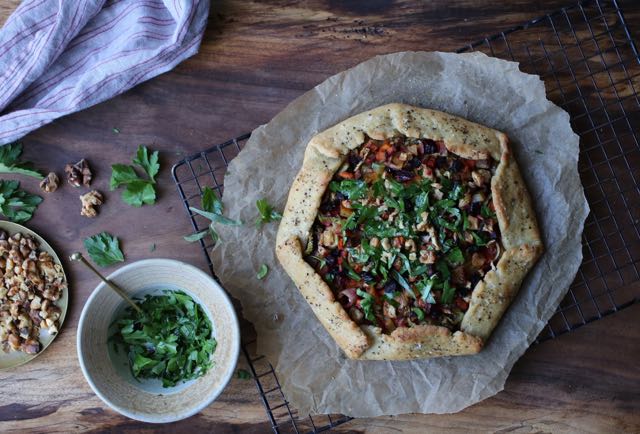

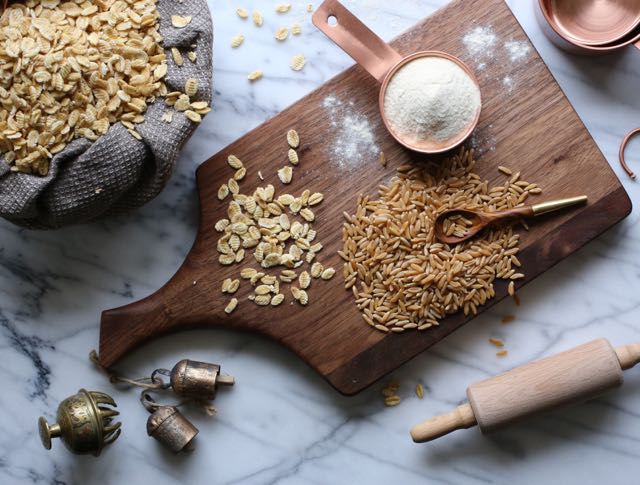


Galette | Crostata | Tart
Needless to say, I’m really impressed by the quality, versatility and flavor of KAMUT. That’s why I’m so excited to share this galette (or crostata or tart) recipe with you. KAMUT flour may be a bit challenging to find in your local grocery store, but you can buy it easily online. Also, if you simply want to make the galette without the KAMUT, you can substitute it with all purpose flour.
There’s quite a bit going on in this galette in terms of texture and flavor and it all comes together beautifully. At its base is a hearty dough made of KAMUT flour and cornmeal. Then there’s a creamy layer of leek pâte that’s spread under the mix of roasted root vegetables. The combined starch and sweetness of the root vegetables benefit from a bit of acid so to finish it gets dressed with a red vinegar-walnut-parsley and tarragon vinaigrette.
The recipe for the leek pâté is adapted from Chef Tal Ronnen’s Crossroads cookbook. As leeks are not naturally spreadable, here they’re cooked for a while to breakdown the fibers and enhance their flavor. Once blended and given time to solidify, its texture is similar to a traditional pâté. The recipe will yield more than you need for this tart. You can use leftovers to spread on crispy crackers like these plant-based crackers.
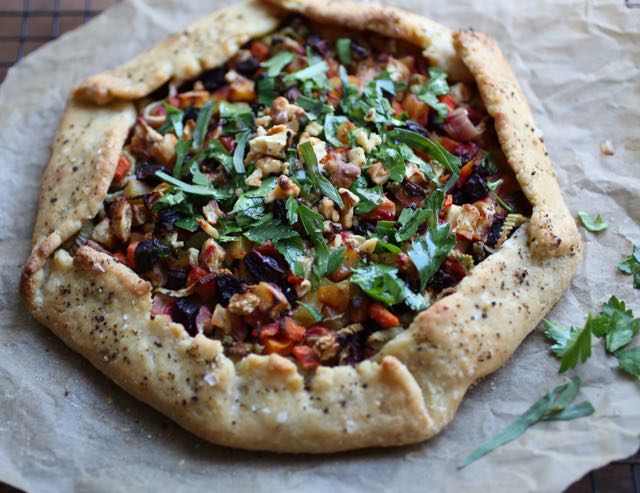



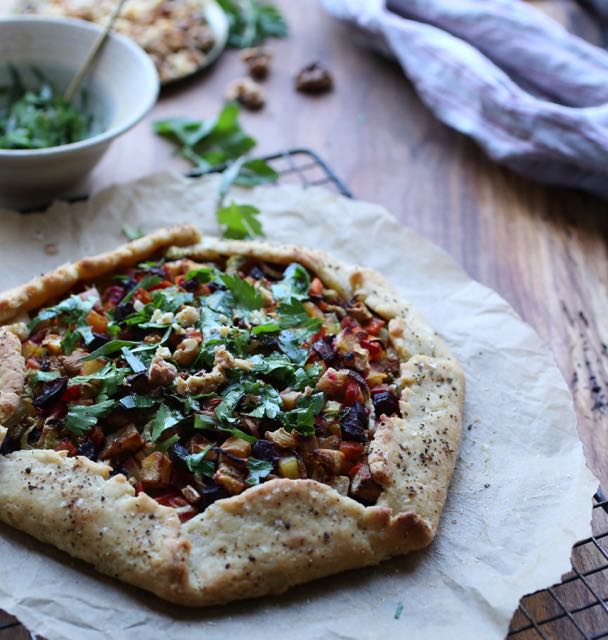
For the filling you can use a variety of different root vegetables. Here, I use a mix of celery root, parsnips, beets, carrots, Yukon Gold potatoes, and a wild card—anise-flavored sliced fennel that goes well with beets. Rutabaga, if you have it, is another option.
I’ve also made this galette with just red and golden beets, and sometimes have swapped fingerling potatoes for the Yukon Gold. Below and throughout this post are photos of several different versions.




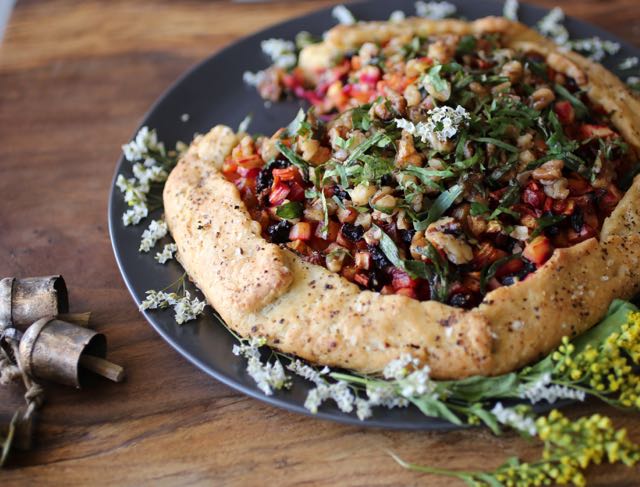
Root Vegetable Galette with KAMUT and Fresh Herbs
Serves 4-6
Tart Dough
1 cup / 150 grams KAMUT flour
¼ cup / 35 grams yellow cornmeal
1 teaspoon / 5 grams cane sugar (optional)
½ teaspoon / 2 grams kosher salt
7 tablespoons cold vegan butter (I used Earth Balance butter), cut into chunks
1/3 cup cold plant milk
flaky sea salt and freshly ground pepper
Leek Pâté
½ pound (about 200 grams or 2 cups) leeks, white and pale green parts only
4 tablespoons (½ stick) butter substitute (I used Earth Balance)
½ cup vegetable stock
½ cup dry white wine (or use more vegetable stock, if preferred)
kosher salt and freshly ground black pepper
Roasted Root Vegetables Filling
3 small red and/or golden beets, peeled and diced small
2 Yukon Gold potatoes, peeled and diced small
1-2 carrots, peeled and diced small
1-2 parsnips, peeled and diced small
1 celery root, peeled and diced small
4-8 cloves garlic, sliced
1 bulb fennel, sliced thinly
Topping
½ teaspoon olive oil
½ cup walnuts, chopped
1 clove garlic, minced
2 teaspoons walnut oil
1 tablespoon red wine vinegar
1 tablespoon fresh parsley, chopped
1 tablespoon fresh tarragon, lightly chopped
kosher salt
freshly ground pepper
Make the dough. In a large bowl, combine all dry ingredients. Add chunks of butter and mix until you have what looks like sandy coarse meal. You can use a stand mixer or food processor for this step, but I prefer to use my hands. Slowly add milk until mixture begins to gather into a ball. You may need an additional tablespoon of milk.
Turn the dough out onto a lightly floured surface. Knead it a couple of times, gathering it into a smooth ball that is not sticky to the touch. Flatten the ball into a disk and wrap in plastic wrap. Chill until very firm, at least a few hours.
Meanwhile, make the leek pâté. Halve the leeks lengthwise, rinse well under cool water, checking for dirt between the layers. Drain well, then cut crosswise into ½-inch slices.
In a large pot under medium heat, add the leeks, butter substitute, stock, and wine, if using. Stir to combine. Bring the mixture a simmer, reduce heat to a gentle simmer, and cook uncovered until the leeks are butter-soft, about 40 minutes. Season with salt and pepper.
Use a slotted spoon to carefully transfer the leek mixture to a high speed blender of food process. Pulse until coarsely puréed. If necessary, pour in some of the leek cooking liquid a little at a time, processing the pâté until smooth. Set aside to cool.
Roast vegetables. Preheat oven to 425F. Line a baking sheet with parchment paper.
In a medium-size bowl toss beets in olive oil, salt and 2-3 cloves garlic. Spread on parchment lined baking pan. Roast until tender, about 30-35 minutes. Set aside.
In the same bowl, combine all the other vegetables, except for the fennel. Toss in olive oil, salt and garlic. Roast until browned and tender, about 30-35 minutes. Set aside to cool slightly. Note: you can combine all the vegetables together to roast, but I like to keep the beets separate so they don’t color all the other vegetables so quickly. Because the sliced fennel is a bit delicate, I prefer to add them to the mix when the tart bakes.
Combine all roasted veggies (beets and other root vegetables). Add sliced fennel.
Assembled Tart. On a floured surface, roll dough to a roughly 10-12-inch circle (or cut the dough into four equal parts to roll out four circles about 7-inches in diameter). Place about ¾ cup of the leek pâté in the center of the dough and spread, leaving a 1½-inch border all around.
Spread roasted vegetables and fennel mixture over the leek pâté. Gently fold up the sides to create a border, as in a free-form galette. Brush the vegetables lightly with olive oil and brush the pastry edges with plant milk. Sprinkle veggies, including the pastry border, with coarse salt and freshly ground black pepper. Bake until pastry is golden brown, about 25-35 minutes.
Meanwhile, make the herb dressing. Heat olive oil under low heat, add the walnuts and cook and stir until golden, about 3 minutes. Remove from the heat and stir in the garlic. Toss well. Transfer mixture to a small bowl and toss with walnut oil. Cool to room temperature, then stir in red wine vinegar, parsley and tarragon. Season with salt and pepper. When tart comes out of the oven, sprinkle herb dressing. Serve warm or at room temperature.

This looks absolutely divine!
Thank you so much!
Precious hands and words of wisdom! Beautiful dish too!!
Thank you Susan. I’m glad you like this post!!
A beautiful reminder.
To be a tree – “A tree is more than its fruit;
we must cultivate our whole selves from
the roots up.” – Thomas Merton.
Lovely quote. Thank you!
Love Kamut, it’s great for making breads! Too bad not many people use it. I miss that little man 🙂
Yes! I heard it’s great for bread too! Have you tried? I’m hoping to try using it for bread and soon. Let’s get together soon. Until then, enjoy the snow! 😊
Yes bread, muffins, and pancakes! The boys love it. I wish I had time to write a post about it!!! Yes, I am enjoying the snow, I can’t believe I was laying down under the coconut trees in Dakar last week 🙂
Coconut trees in Dakar, nice! 😊👍 All the baked goods you mentioned, along with pie and waffles are on my “to make with Kamut” list.
Great post. I think introspection is always a great start. I love your quotes, especially from Leonard Cohen. Beautiful photos and thought provoking insight. It’s nice to hear that someone who’s focusing on mindfulness and loves her son can lose patience too. It’s natural. I like to remind myself that every moment is a chance for a do over.
Hi Amanda, a lovely and very thoughtful comment, thank you. You’re right, every moment is an opportunity to grow and do better. It’s something I need to get better at reminding myself everyday…a work in progress. Thanks again and the very best of wishes to you this year!
Beautiful words. Words for us all to ponder deeply in a quiet moment. Good luck with ur garden! It’s a wonderful feeling serving home grown organic veg at the table. Ps: theclevercarrot has some great posts on making sourdough. She certainly helped me a lot. Happy new year.
Thank you Nicola. A very Happy New Year to you too! I tried growing herbs last year and now I want to try vegetables. It was wonderful to clip herbs and them from my pots and then use them for meals. I can imagine the feeling will be must be 10x greater with organic vegetables. Thanks for the resource on bread making. I will take a look!
As much as I enjoyed your article and photographs I wish that only the recipe would print. It was 25 pages too many.
Hi Penny, I can imagine your frustration. I’m working on making it easier to print just the recipe. Hopefully this will be fixed soon! Sorry for the inconvenience!!
For now, you can highlight and copy the recipe into Word, as one possibility. If not, I can email it to you. Please let me know if you’d prefer that option.
Thank you but I have the recipe and then some LOL. I look forward making the galette.
I hope you love the recipe and it’s worth the hassle! I’m sure there’s got to be an easy way to install the print function, I just haven’t figured it out yet. Hopefully I’ll have the site redesigned for the better soon. If there’s anything else that would make the site more user friendly, feel free to let me know! 😉